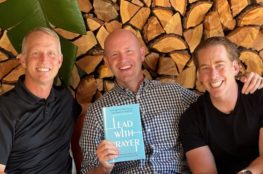Today’s guest blog post is written by my friend Russ Debenport, who serves as the chief strategist at Strategy for the People. In his role, Russ partners with organizations to better accomplish their core purpose. His people-centered approach, valuable expertise, and years of experience have equipped HOPE to better implement our mission.
In this time where many of us are refocusing and reprioritizing, Russ prompts us to stay focused on what matters most—and to do so alongside others. His rooting-for-rivals approach empowers organizations to scale mission and grow impact through strategic collaboration. Enjoy!
It was painfully hot in Phoenix, Arizona, the day I locked our office doors for the last time. In the short span of 30 days, I had laid off 50 staff; sold as many chairs, desktop computers, and staplers (I still have one); and wound down the operation of my first real leadership job. It was a brutal ending to my role as vice president of client services for a consumer credit counseling nonprofit start up. I still clearly recall one conversation with our CEO in the final days as we lamented what could have been. I openly wept in front of him as the weight of the impact on staff and our customers soaked in. We were the first 24/7 contact center enabling consumers around the United States to call any time, night or day, for advice, budgeting, and debt repayment planning. In 1999, we were among the pioneers offering online financial counseling—cutting edge at the time. Our product was great, but our timing was horrible. The economic boom of the late 90s meant few consumers were interested in financial counseling. So, after two years of operations during one of the most prosperous periods in recent U.S. history, we were forced to close our doors. Bad timing can sink an otherwise good idea. But what if we had found another way to continue the mission?
In recent weeks, the world has been stunned by a global health and economic crisis. The unfolding COVID-19 pandemic threatens life and livelihoods, having put approximately 33 million U.S. citizens out of work over a seven-week period and creating a 4.8% reduction in GDP for the first quarter of 2020. Over 1.6 billion children around the world are out of school. Some are predicting that this is much more than a short-term storm, but a season of change and possibly an “ice age” with permanent impacts on social norms and business practices. McKinsey & Company recommends responding across five time horizons reaching as far out as two years. One thing is certainly clear: nonprofit leaders must consider bold moves in response to these events to stay on mission.
To begin, we must consider the current state of the nonprofit sector in the U.S. As of 2015, there were 1.56 million active nonprofits in the U.S., having increased by 10.4% from 2005. The nonprofit sector is the third largest employer in the country with 12.3 million people employed as of 2016, just behind retail and accommodation and food industry sectors. Yet, while the sector is large and influential, a significant majority of nonprofits have small operating budgets. In fact, 43% operate on less than a $500,000 annual budget. Many of these nonprofits compete for the same donor dollars and foundation grants while duplicating support services like H.R., technology, and finance. Will the current nonprofit landscape be able to serve our constituents with excellence and thus fulfill our missions in the current climate? As people of faith, could we find creative ways to radically improve efficiency without sacrificing our missions—and even innovate for greater mission impact as part of God’s Kingdom?
In response to these pressing questions and our unprecedented times, Strategy for the People is launching a new approach. In collaboration with Globe Consulting and Oakley Global Consulting, we are announcing Mission-Advancing Alliances & Mergers services to help organizations assess their current situation, explore new alliances or mergers, and execute in order to build new mission opportunities. Together, we can make 1 + 1 = 3. Now is the time for Christ-centered nonprofit leaders to join forces and explore bold alternatives. Don’t lay off staff and start selling the staplers before you consider mission-advancing alliances and mergers. Here are a few factors to consider first:
- Your organizational mission is what’s most important. Finding significant new efficiencies through alliances or mergers can enable more mission. Don’t settle for less.
- To find suitable partners for collaboration, consider commonalities and complementarity across mission, culture, and strategy, leading to greater outcomes.
- Best practices show that an independent third party is essential for successful consolidation.
In the coming weeks, Strategy for the People will release more ideas and practices on how nonprofits can form alliances or mergers successfully. And if you’re curious to learn more, please contact me to start a conversation. I look forward to exploring what the future can look like together.
——–
This blog post was originally published on the Strategy for the People blog.
 Russ Debenport is the chief strategist at Strategy for the People. In this role, he works with organizations to build strong teams, establish clarity, and advance mission. Russ has over 25 years of experience in over 40 countries and has worked with organizations like the Chalmers Center, the Mayo Clinic, and Compassion International. With a human-centered, cross-disciplinary, conversational strategy style, Russ has helped dozens of nonprofits—from startups to well-established organizations—to implement and scale their mission. Learn more at strategyforthepeople.com.
Russ Debenport is the chief strategist at Strategy for the People. In this role, he works with organizations to build strong teams, establish clarity, and advance mission. Russ has over 25 years of experience in over 40 countries and has worked with organizations like the Chalmers Center, the Mayo Clinic, and Compassion International. With a human-centered, cross-disciplinary, conversational strategy style, Russ has helped dozens of nonprofits—from startups to well-established organizations—to implement and scale their mission. Learn more at strategyforthepeople.com.



